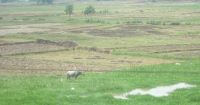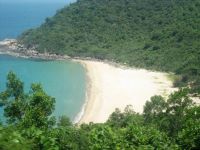The 120-mile Cu Chi tunnels that we visited today may well be epigrammatic for a history of Viet Nam; the tunnels show the determination of the Vietnamese people to persevere in the face of great odds against invaders. The tunnels, about 40 miles from Saigon, were dug in the hard clay soil beginning during the post-World War II war against the French. Twenty-five years later, the tunnels had been expanded to develop a city underground that at one time accommodated over 10,000 people. Some of the most bitter fighting of the American war was around Cu Chi. That included the dropping of 130 million tons of bombs; tunnel rats who went into the caves, which had three levels—as deep as 27 feet. Some of the bombs contained Agent Orange, which rearranged genes and the  environment, denuding areas to this day, and deforming people permanently. The guide challenged us to find an opening, as our GIs tried to do—and we had no success; the entrances were camouflaged and small enough for its inhabitants. Maybe 8×10 at most.
environment, denuding areas to this day, and deforming people permanently. The guide challenged us to find an opening, as our GIs tried to do—and we had no success; the entrances were camouflaged and small enough for its inhabitants. Maybe 8×10 at most.
The macabre “theme park” included an opportunity to fire machine guns or AK47s. It also included some grim displays of people traps—bamboo stakes and pits with maimers and killers that our guide cautioned me about. He said a lot of older American groups consider it propaganda; as I told our students, if they want to see the American equivalent, The Green Berets is “our” propaganda.
In the free time we had before leaving, I walked through the French Cathedral (1886)/Post office (1891) to the History Museum, housed in a lovely old French building, and probably begun under the French. It tells the story of successive waves of invaders beaten back—the “feudal” Chinese (Song, Ming, Qing, and Mao dynasties), the Cham (Indian-based, which left behind marvelous artifacts here and at Danang), and the numerous dynasties that at various times tried to unify the country—and the peasants who at various times said “enough,” and brought down the dynasty. The last emperor Bao Dai died in Paris in the 60s or thereabouts.
The exhibits reminded me of the indebtedness of Vietnam to Chinese culture (despite the millennium of warfare with the “aggressors,” as the museum described it). I know we’ll see more in Hanoi (Chinese for “in the middle of the river”). Even the language used Chinese characters until a Portuguese priest developed an alphabet. Given the numerous Chinese (especially in Saigon, which has a Chinese section called Cholon), you sometimes find Chinese characters as well.
Buddhism came to Vietnam through China, which is why it’s similar to what we’ll find in East Asia. That was of especial interest because today was (at least here) the celebration of the Buddha’s birthday. I asked to stop at one temple to see how it is celebrated (I’ve washed the Buddha in Hong Kong, for example), and our guide noted that this temple had produced some of the monks who, in opposition to the Diem regime during the Vietnam war, had doused themselves in gasoline and immolated themselves (that black and white photo again). Much of the museum collection was from rich people whose idea of luxury was to have goods similar to those of the wealthy Chinese. It’s part of the model that helps define the Chinese cultural sphere (China, Vietnam, Korea, Japan, Malaysia, Taiwan, Thailand, Indonesia and the Chinese diaspora elsewhere).
We’re on our way to Hanoi—via a 33-hour train ride. Jim and I are sharing a compartment with a Vietnamese couple and their oh-so-cute 3-year-old daughter. We’re about to leave, and I’ll probably have time to observe the countryside of this long (over 1,000 miles to Hanoi), but thin country. It is 5 a.m. here, and we’ve just arrived in Hanoi. As I expected, it was a National Geographic trip. Some of it was in black and white, the imagery from the  1960s—the paddy fields, with cone hats on the farmers, water buffalo supplying cow power, the haystacks forming interesting shapes (more interesting than Monet) as the beasts ate away, graves in the middle of fields, even some corn to remind us of the Midwest.
1960s—the paddy fields, with cone hats on the farmers, water buffalo supplying cow power, the haystacks forming interesting shapes (more interesting than Monet) as the beasts ate away, graves in the middle of fields, even some corn to remind us of the Midwest.
The National Geographic-est (if I may coin a phrase) was probably the  stretch from Danang over the mountains to Hue. Danang sits on the Vietnam Sea (that’s what the South China sea is called here); it’s where 50,000 American troops waded ashore in 1965, escalating the “adviser” stage to the war stage of the Vietnam War. The bay is beautiful, and to go up and over, the French built three tunnels and hugged the bay. You had to know what to look for in Hue—and I’d been here in 1995, so I had a pretty good idea. Hue was the capital of the Nguyen Dynasty (the last one, which ended after WWII), with what’s left of a forbidden city (I saw the walls from the train), three open imperial tombs (mimicking the Chinese Imperial tombs), and, when I saw it, the flagpole from the citadel. A huge flagpole, it’s another of the 1960s black and white TV memories—the hoisting of the VC flag over Hue during the Tet Offensive of 1968, which was the watershed in the war—the point at which ending it predominated over winning it.
stretch from Danang over the mountains to Hue. Danang sits on the Vietnam Sea (that’s what the South China sea is called here); it’s where 50,000 American troops waded ashore in 1965, escalating the “adviser” stage to the war stage of the Vietnam War. The bay is beautiful, and to go up and over, the French built three tunnels and hugged the bay. You had to know what to look for in Hue—and I’d been here in 1995, so I had a pretty good idea. Hue was the capital of the Nguyen Dynasty (the last one, which ended after WWII), with what’s left of a forbidden city (I saw the walls from the train), three open imperial tombs (mimicking the Chinese Imperial tombs), and, when I saw it, the flagpole from the citadel. A huge flagpole, it’s another of the 1960s black and white TV memories—the hoisting of the VC flag over Hue during the Tet Offensive of 1968, which was the watershed in the war—the point at which ending it predominated over winning it.
But of course the highlight of the train ride was the “Hanoi Station,” because we knew what that meant—shower, brief nap, and more sightseeing in the capital of Vietnam.